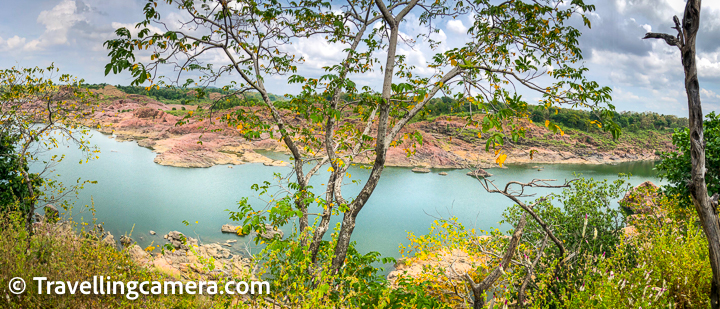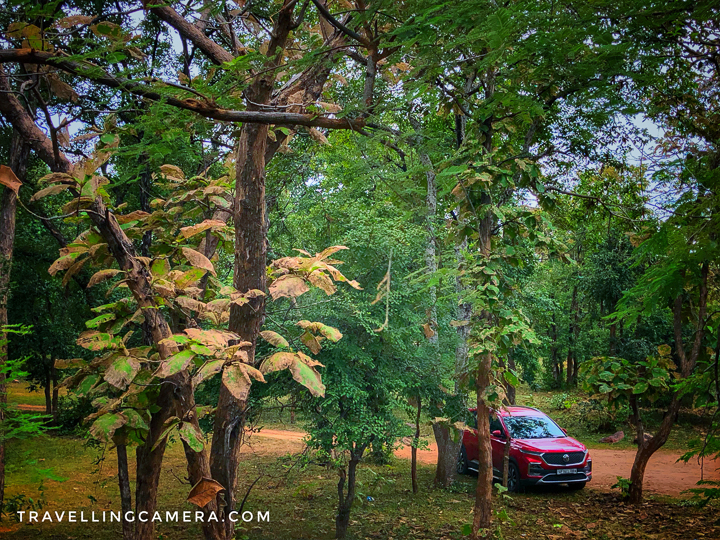Raneh Falls - A preserved area with Magnificent Waterfall around underrated Canyon with colourful rocks and lush green Forest with active wildlife around Ken river in Khajuraho, Madhya Pradesh
When we visited Khajuraho in Madhya Pradesh, we had a packed first day when we explored the Western, Eastern, and Southern Groups of temples. And after we were done with that, we had another complete day in the city. So we decided to visit some of the nearby places. We planned for Raneh Falls in the first half and then explore Pandava Caves in the second half. Pandava Caves did not happen because we ended up going for a safari in Panna National Park (Read about that exciting experience here), but Raneh falls did, and it was absolutely wonderful.
We have learnt to expect disappointment at most waterfalls that are tourist places. A google search evealed that Raneh Falls is not just a waterfall, and is often referred to as "Grand Canyon of India". However, such keywords are so cliché that more often than not, the places turn out to be overhyped. However, this was reverse in case of Raneh Falls.
Related Blogpost - How to plan a trip to Grand Canyon from Las Vegas, USA
Since we had spent almost the entire trip waking up really early and walking around throughout the day, we decided to take it easy and start a little late. This turned out to be the wrong call and I will tell you why a little later. By the time we had finished breakfast at Lassi Corner and headed out, the sun was high up and it was sunny.
Related Blogpost - Early morning walk around Zero-point in Binsar Wildlife Sanctuary || Uttrakhand Diaries
Raneh falls is about 21 kms from the Western Group of Temples and the drive was through fields and villages. We put on old bollywood music in the car and started the journey. The road is narrow and there are some rough patches, but it meanders through fields and villages and the lasting memory is that of a pleasant, calm drive.
Related Blogpost - Travel Guide for Monteverde Cloud Forest Reserve, Costa Rica - Pura Vida !
Related Blogpost - Spots and Stripes at Panna National Park || Guess what we saw at the Tiger Reserve
Related Blogpost - Khajuraho one day Itinerary - How to spend a day around this World Heritage City of Madhya Pradesh in best way ?
Anyhow, we reached the gates of Raneh Falls in about 45 minutes. The entry fees for our car was Rs 300 + Rs. 150 for a mandatory guide. If you do not have a vehicle, you can take an auto. The charges for that is Rs. 200. It is important to take a vehicle because the area to be explored is huge. The guide does not add much value, mostly because the guides are not too knowledgeable. However, that is not optional so you need to take one along. We made peace with this. The guy who accompanied us was a nice guy, so we were not too bothered by him tagging along.
The first part of Raneh Falls area that the guide takes you through is the forest area. You first head out to the farthest point, which is known as the Ken Gharial Sanctuary. It is really just a point in the Forest from where you can look down into Ken Gorge and at times spot Gharial's sunning themselves on the rocks below. We weren't that lucky and apparently it was not the right season.
Related Blogpost - Day well spent around Meenangadi, Edakkal Caves and Curuva Island in Waynad region of Kerala, India
There was also a watch tower here that you can climb to get a wider view of the forest and the canyon.
Related Blogpost - Birding opportunities around Binsar Wildlife Sanctuary, Uttrakhand, India
After that, you drive through the jungle for a bit. You do come across some wildlife. We saw some langoors - for some reason some langoors had patronized individual trees. In a particular part of the forest, beneath each tree, there was one langoor sitting on the ground. Probably they were just protecting themselves from the sun, but it was not clear why there was just one langoor beneath each tree. We came across spotted deer and one antlered male made our day by dashing across our path. We felt really close to the wildlife in that moment. Apart from deer and langoors, there are also jackals, hyenas, peacocks etc. We saw some peacocks and also one Jackal, but that was outside the designated wildlife area.
Related Blogpost - Day Tour around San Francisco - Muir Woods, Mt. Tamalpais, Twin Peaks & Golden Gate Bridge
After that the guide took us towards the trail, where you can potentially go for a walk, but we skipped this part because it was really very hot by now. And that was one reason why the decision to start after 9 AM was the wrong one. First, it was very hot by the time we reached the forest. Second, there were hardly any birds around. The guide told us that early in the morning we would have spotted many beautiful birds.
Related Blogpost - Khecheopalri Lake and Beyond || A Hidden Opportunity to Take Up a Short Trek
After this, we headed to the viewpoint from where one can view the waterfalls. The "Falls" in Raneh falls aren't the usual falls where one can stand under the fall and wade in the pool. The falls are actually only viewed from a distance, and the surrounding landscape is so overwhelming in scale and colors that the falls are just a small part of it. The attraction that is sold as "Raneh Falls", should actually be called "Raneh Canyon and Forest Area". That does better justice to this place.
Related Blogpost - Camping in dense forests surrounded by snow covered hills around Narkanda & Hatu peak of Himachal Pradesh
Another unique aspect of these "falls" is that usually when you plan to visit a waterfall, you prefer the time of the year, when there is maximum water. But here, it is the reverse. You should plan to go when the water levels are low, because only then will you see the natural art that the River Ken (Karnavati) has sculpted and painted over eons. During monsoon and immediately after it, water levels are so high that the entire canyon gets submerged. The canyon is huge and if you imagine the amount of water that would be required to cover it, you can get the sheer scale of natural environment.
Related Blogpost - Exploring the tea estates of Wayanad on a bicycle || Kerala Diaries
......
Our guide showed us a video of a couple of years back when the monsoon was specially generous with rain, and I have to admit that I was shocked at the amount of water and its force. You then look at the canyon and you realize that water indeed is a force beyond our imagination. It is persistent, and can be violent, but mostly it does its work in silence. The River Ken is calm for most part of the year, it is only during the monsoon that it takes on its rudr roop.
Related Blogpost - Landscapes from Barot Town of Himalyan State of India - Himachal Pradesh || Barot - A Picnic Spot for True Nature Lovers
The canyon at Raneh has been carved out by the River Ken flowing through volcanic rocks. Also visible is the mouth of an extinct volcano that is now filled with water. There are 5 types of Volcanic Rocks at Raneh - green dolomite, black basalt, brown quartz, red Jasper and pink granite. So when the water is low you can see all these layers and the canyon indeed appears very vibrant.
......
This was the last point at Raneh and after this we had cold drinks at the small canteen. We then bid goodbye to our guide and drove off happily to our next destination. It is quite a special feeling when a tourist place exceeds your expectations, because usually it is the reverse that happens. We definitely recommend a visit to this incredible place.
If you liked this post and found it helpful, I would request you to follow these things when traveling -
1. Manage your waste well and don’t litter Use dustbins.
2. Tell us if you went to a place and found it hard to locate a dustbin.
3. Avoid bottle waters in hills. Usually you get clean water in hills and water bottles create lot of mess in our ecosystem.
4. Say big no to plastic and avoid those unhealthy snacks packed in plastic bags. Rather buy fruits.
5. Don't play loud blaring music in forests of jungle camps. You are a guest in that ecosystem and disturbing the locals (humans and animals) is not polite.
















.jpg)
Comments